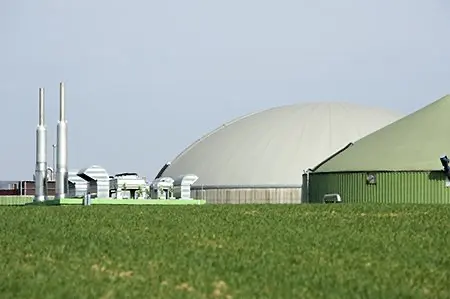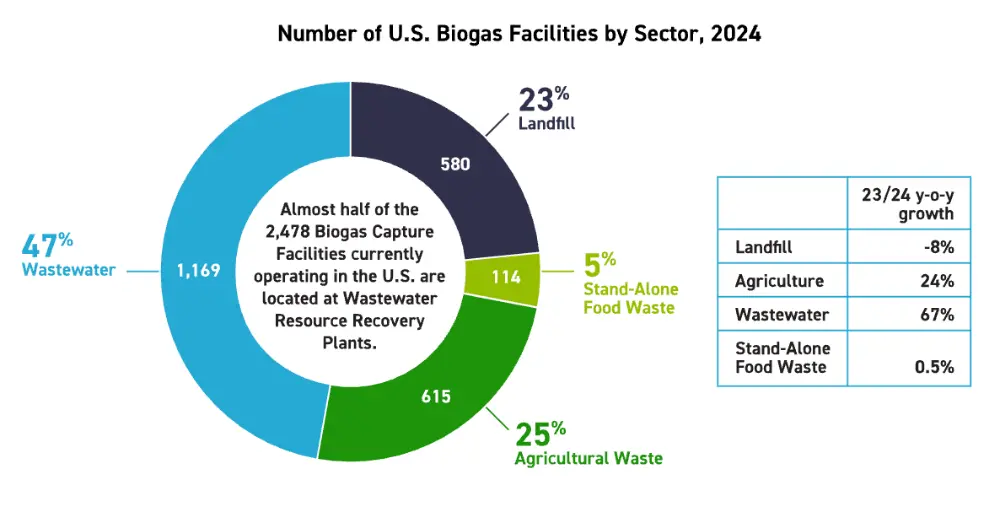Investment in new biogas projects in the U.S. grew by $3 billion in 2024, according to recently released data from the American Biogas Council.
Between January and December 2024, 125 new biogas projects were launched across the U.S., representing more than $3 billion in new investment. The number of new projects in 2024 rose by 17% compared to 2023, while the total capital invested increased by 40% year over year.

Biogas facilities convert organic waste—including manure, wastewater, food scraps, and captured landfill gas—into renewable natural gas (RNG), electricity, thermal energy, and nutrient-rich fertilizer. Collectively, these segments of the industry generated over 10% more biogas in 2024 than in any previous year.
With the latest additions, the total number of biogas facilities in the U.S. has reached nearly 2,500. These sites now produce close to 1.4 million standard cubic feet per minute (scfm) of biogas, a form of dispatchable renewable energy. That energy output is equivalent to what could be generated by approximately 15,000 football fields covered in solar panels, enough to power 2.4 million homes for a year or to replace the fuel used by 2.6 million gasoline-powered cars.
Biogas also offers significant climate benefits, with a carbon intensity 50% to 700% lower than that of fossil fuels. This is due to the capture of methane—a potent greenhouse gas—that would otherwise be released, and its use as a substitute for fossil energy and synthetic fertilizers.
“The biogas industry keeps hitting new growth records every year because, as an energy source, biogas just makes sense. It provides much-needed clean electricity, cuts pollution and emissions from transportation, and provides heat-producing fuel for industries, all while managing millions of tons of waste from farms and cities alike,” said ABC Executive Director Patrick Serfass. “In a time when demand for domestic energy is increasing significantly, fertilizer markets are constrained by the Ukraine conflict, and America is striving for energy and industrial dominance, the value of 24/7/365 energy and locally produced, natural fertilizer from biogas projects is undeniable.”

Landfill gas (LFG) projects—which capture methane generated as organic waste decomposes in landfills—account for most of the biogas production in the United States, contributing 72% of total output. This dominant share comes despite the LFG sector having fewer facilities than the agricultural and wastewater segments. In 2024, 24 new LFG projects were brought online, raising the total number of operational LFG sites to 580—a 4.3% increase from the previous year.
These new projects represent approximately $1.4 billion in investment, or 47% of all capital committed to biogas development in 2024. The added capacity pushed the sector’s output up by over 12%, with total LFG production reaching around 980,000 standard cubic feet per minute (scfm). While many of the more recent projects are designed to upgrade biogas into renewable natural gas (RNG), most LFG facilities—roughly 77%—continue to generate electricity from captured methane.
While landfill gas production saw notable gains in 2024, the agricultural sector led in new development, launching 93 farm-based biogas projects—nearly four times the number of new landfill projects. For the first time, the total number of agricultural biogas facilities surpassed landfill-based systems. These new projects represented $1.37 billion in capital investment, primarily in rural areas, and marked a 24% increase over the number of farm projects added in 2023. The sector grew by nearly 18% overall, with total agricultural biogas facilities increasing from 522 to 615. These additions contributed 21,000 standard cubic feet per minute (scfm) of new biogas production. Notably, hog farms saw increased participation, accounting for 29 new projects, or 31% of all new agricultural installations. Farmers continue to explore more efficient methods of managing animal waste.

A major trend in 2024 was the growing emphasis on renewable natural gas (RNG). Of the new agricultural biogas systems, 95% were built with RNG production as their primary goal. RNG projects now outnumber biogas-to-electricity systems in the farming sector by a ratio of roughly three to two.
Although the wastewater sector did not experience the same pace of growth, it continues to represent the largest share of biogas facilities—about 47% of all installations—and boasts the longest operational history. Some of the earliest biogas systems still in use were installed at wastewater treatment plants in the 1920s, using anaerobic digestion to reduce sludge volumes during water treatment.
Standalone food waste biogas systems remain the least common due to their technical complexity. However, three new food waste-only facilities came online in 2024, raising the total to 114. Despite their smaller numbers, roughly 200 agricultural and wastewater biogas systems currently co-digest food waste with manure or biosolids, expanding the sector’s reach. Growth is expected to accelerate in 2025, with 16 dedicated food waste projects already under construction.
Of the 125 new biogas projects developed in 2024, 119—about 95%—were designed to upgrade their biogas into RNG. This trend has been consistent since 2018, largely driven by incentive programs such as California’s Low Carbon Fuel Standard (LCFS) and the federal Renewable Fuel Standard (RFS), which reward producers that cut transportation emissions. Despite RNG’s rise, electricity remains the primary end use for biogas. More than 77% of all biogas facilities, and 60% of total output, are still used to generate renewable electricity—highlighting the ongoing significance of power generation in the sector.
Biogas projects now operate in every U.S. state, as organic waste is a universal byproduct of both human and animal populations. The recent increase in agricultural projects has drawn investment to rural, agriculture-heavy regions. Investment decisions are also shaped by the availability of untapped landfill sites. In 2024, California, Illinois, South Dakota, Pennsylvania, and Virginia saw the most capital invested in biogas projects that came online. The previous year, Michigan, Indiana, Virginia, Ohio, and Texas topped the list.
Each year, Americans send more than 1.4 billion tons of manure, 33 million tons of inedible food waste, and 1 million tons of wastewater biosolids to landfills. Additionally, 470 landfills currently flare methane that could be captured and repurposed. According to the American Biogas Council (ABC), more than 20,000 new biogas systems could still be developed to convert this waste into energy and usable products—creating jobs and reducing emissions in the process.
These future projects have the potential to generate up to 20 gigawatts of continuous electricity, while supporting an estimated 740,000 short-term construction jobs and 25,000 permanent roles in operations. Additional supply chain job creation is also anticipated.
The ABC views biogas expansion as a key economic opportunity. Further industry development could reduce landfill dependence, lower methane emissions, support domestic energy production, provide sustainable fertilizers that enhance crop yield and food quality, and generate well-paying jobs in both rural and urban communities.
GPRS supports biogas facility projects through our comprehensive suite of subsurface damage prevention, existing conditions documentation, and construction & facilities project management services.
Our 99.8%+ accurate utility locating and concrete scanning services mitigate the risk of subsurface damage when you must break ground. We use 3D laser scanning to capture these markings, as well as all above-ground details for future use. And our in-house Mapping & Modeling Department can use this data to create complete, accurate as-built drawings and 3D Building Information Modeling (BIM).
All this data is at your fingertips 24/7 thanks to SiteMap® (patent pending), GPRS’ project & facility management application that provides accurate existing conditions documentation to protect your assets and people.
GPRS Intelligently Visualizes The Built World® to keep your projects on time, on budget, and safe.
What can we help you visualize?
Frequently Asked Questions
Can you find PVC piping and other non-conductive utilities?
GPR scanning is exceptionally effective at locating all types of subsurface materials. There are times when PVC pipes do not provide an adequate signal to ground penetrating radar equipment and can’t be properly located by traditional methods. However, GPRS Project Managers are expertly trained at multiple methods of utility locating.
Will I need to mark out the utilities GPRS locates?
No, GPRS will locate and mark all utilities for you. We have a variety of tools and markers we can use to highlight the locations of utilities, underground storage tanks and whatever else may be hiding.
What are the Benefits of Underground Utility Mapping?
Having an updated and accurate map of your subsurface infrastructure reduces accidents, budget overruns, change orders, and project downtime caused by dangerous and costly subsurface damage.
How does SiteMap® assist with Utility Mapping?
SiteMap®, powered by GPRS, is the industry-leading infrastructure management program. It is a single source of truth, housing the 99.8%+ accurate utility locating, concrete scanning, video pipe inspection, leak detection, and 3D laser scanning data our Project Managers collect on your job site. And the best part is you get a complimentary SiteMap® Personal Subscription when GPRS performs a utility locate for you.
Does SiteMap® Work with my Existing GIS Platform?
SiteMap® allows for exporting of data to SHP, GeoJSON, GeoPackage, and DXF directly from any user’s account that either owns or has a job shared to their account. All these file formats can be imported and utilized by other GIS packages if manually imported by the user.
